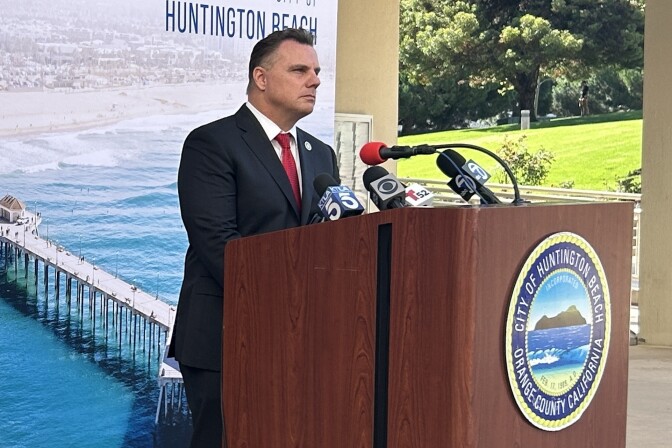Topline:
A new report by several state agencies found that the water supply during the Palisades Fire was too slow, not too low, and even a functioning Santa Ynez Reservoir likely wouldn’t have helped much.
Why the hydrants stopped working: “The water system lost pressure, not due to a lack of water supply in the system, but because of an insufficient flow rate,” the report states.
Could it have been prevented? Though the exact data was missing, the state agencies running the investigation found that it was “unlikely that [the reservoir] could have helped maintain pressure for very long.” Municipal water systems like L.A.’s are not designed to fight large-scale urban conflagrations. Their main function is delivering drinking water.
What’s next: The repairs to fix the Santa Ynez Reservoir’s broken cover and make it usable again are slated to begin in June and finish by May 2027.
Read on ... to learn what the report recommends.
As the Palisades Fire was still burning in January, residents saw an eye-grabbing headline: the Santa Ynez reservoir, perched directly above the Palisades, was offline for repairs and empty.
The reservoir’s closure frustrated residents and spurred Gov. Gavin Newsom to announce a state investigation into whether the reservoir being full of water would have made a difference fighting the deadly fire.
After months of analysis, California agencies including the state’s EPA, Cal Fire and the Department of Water Resources issued a report confirming the explanations given by local officials and experts in the aftermath of the fire: the water supply was too slow, not too low — and even a functioning reservoir likely wouldn’t have done much in the face of an unprecedented natural disaster.
Why the hydrants stopped working
The report found that not even a full reservoir positioned uphill from the Palisades Fire could have maintained water pressure and stopped the devastation.
“The water system lost pressure, not due to a lack of water supply in the system, but because of an insufficient flow rate,” the report states.
A reservoir perched at a high elevation, such as the Santa Ynez, can serve an important role in maintaining water pressure for hydrants throughout the system. As water gets used downhill, water from the reservoir flows to towers that maintain water pressure. Because of gravity and physical limitations on flow rates, the pressure towers can't be refilled at the same pace as they are drained and eventually dry up.
In the case of the Palisades Fire, the report states, a full reservoir would have helped keep water pressure up for only a short time.
The report noted that some data points on the demand on the Los Angeles Department of Water and Power’s system were missing.
However, investigators found that based on experiences with other fires, the high demand across the system meant it was “unlikely that [the reservoir] could have helped maintain pressure for very long.”
The system’s design
The report found that the closure of the Santa Ynez Reservoir was in line with the primary purpose of L.A.’s water infrastructure: maintaining a clean drinking water supply. The reservoir repairs were prompted by a damaged cover. The repairs, the report notes, were required by federal and state laws on drinking water safety.
More broadly, municipal water systems like L.A.’s weren’t built to fight wildfires, as LAist reported in January.
“This report confirms what we and others have been saying more broadly regarding water system expectations and capabilities, but does so completely independently and with new details specific to the L.A. fires,” Greg Pierce, the director of UCLA’s Human Right to Water Solutions Lab, said in an email to LAist.
What’s next
The report makes two major recommendations: continue to follow the California Wildfire and Forest Resilience Action Plan, and make sure firefighters in the state are positioned for year-round fires.
The state stopped short of recommending any changes to L.A.’s municipal infrastructure. Water experts like Pierce say massive amounts of water and a very expensive redesign of L.A.’s water system would be needed to keep fire hydrants working during large urban conflagrations.
For their part, researchers and others have been looking into other solutions, including putting more utility lines underground and redistributing water across the system.
The report about the reservoir comes on the heels of a separate report from the Fire Safety Research Institute about the timeline leading up to and during the January firestorm. That report, which was commissioned by the California governor's office, contains a detailed account of the Palisades and Eaton fires' progressions and emergency services' responses on Jan. 7 and 8.
As for the Santa Ynez Reservoir, the repairs to fix its broken cover and make it usable again are slated to begin in June and finish by May 2027.











